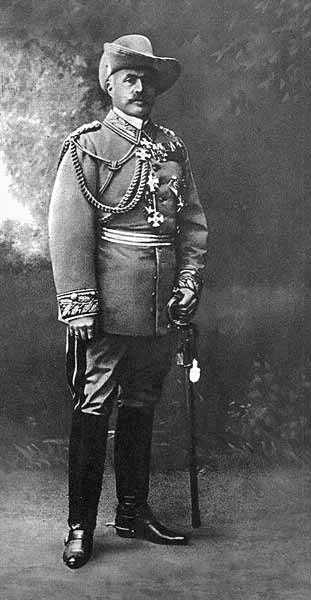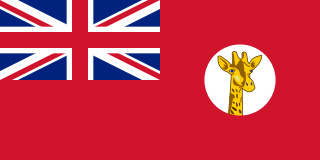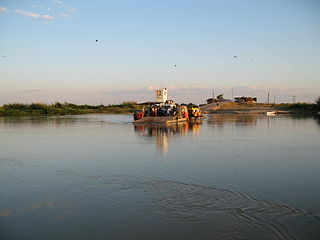The modern-day African Great Lakes state of Tanzania dates formally from 1964, when it was formed out of the union of the much larger mainland territory of Tanganyika and the coastal archipelago of Zanzibar. The former was a colony and part of German East Africa from the 1880s to 1919 when, under the League of Nations, it became a British mandate. It served as a British military outpost during World War II, providing financial help, munitions, and soldiers. In 1947, Tanganyika became a United Nations Trust Territory under British administration, a status it kept until its independence in 1961. The island of Zanzibar thrived as a trading hub, successively controlled by the Portuguese, the Sultanate of Oman, and then as a British protectorate by the end of the nineteenth century.

German East Africa was a German colony in the African Great Lakes region, which included present-day Burundi, Rwanda, the Tanzania mainland, and the Kionga Triangle, a small region later incorporated into Mozambique. GEA's area was 994,996 km2 (384,170 sq mi), which was nearly three times the area of present-day Germany and almost double the area of metropolitan Germany at the time.

The Ndwandwe–Zulu War of 1817–1819 was a war fought between the expanding Zulu Kingdom and the Ndwandwe tribe in South Africa.

Chief Mkwavinyika Munyigumba Mwamuyinga, more commonly known as Chief Mkwawa or Sultan Mkwawa, was a Hehe tribal leader in German East Africa, based in Kalenga, Iringa region, who opposed the German colonization. The name "Mkwawa" is derived from Mukwava, a shortened form of Mukwavinyika, meaning "conqueror of many lands".
Weltpolitik was the imperialist foreign policy adopted by the German Empire during the reign of Emperor Wilhelm II. The aim of the policy was to transform Germany into a global power. Though considered a logical consequence of the German unification by a broad spectrum of Wilhelmine society, it marked a decisive break with the defensive Realpolitik of the Bismarckian era.

General Adrian Dietrich Lothar von Trotha was a German military commander during the European new colonial era. As a brigade commander of the East Asian Expedition Corps, he was involved in suppressing the Boxer Rebellion in Qing China, commanding troops which made up the German contribution to the Eight-Nation Alliance. He later served as governor of German South West Africa and Commander in Chief of its colonial forces, in which role he suppressed a native rebellion during the Herero Wars. He was widely condemned for his brutality in the Herero Wars, particularly for his role in the genocide that led to the near-extermination of the Namaqua Khoikhoi and the Herero.

The German East Africa Company was a chartered colonial organization that brought about the establishment of German East Africa, a territory which eventually comprised the areas of modern Tanzania, Burundi, and Rwanda. The company originated in 1884 as the Gesellschaft für deutsche Kolonisation with the aim of trading in Africa. The German protectorate of Wituland originated as a separate German sphere of influence in 1885.

The Chilembwe uprising was a rebellion against British colonial rule in Nyasaland which took place in January 1915. It was led by John Chilembwe, an American-educated Baptist minister. Based around his church in the village of Mbombwe in the south-east of the colony, the leaders of the revolt were mainly from an emerging black middle class. They were motivated by grievances against the British colonial system, which included forced labour, racial discrimination and new demands imposed on the African population following the outbreak of World War I.

The Abushiri Revolt, also known as the Slave Trader Revolt, but generally referred to by modern historians as the Coastal Rebellion, was an insurrection in 1888–1889 by the Arab, Swahili and African population of the coast of what is now Tanzania. This coast had been leased, under protest, to Germany by the Sultan of Zanzibar in 1888. The rebellion was eventually suppressed by a German expeditionary force commanded by Hermann Wissmann.

Songea is the capital of Ruvuma Region in southwestern Tanzania. It is located along the A19 road. The city has a population of 286,285, and is the seat of the Roman Catholic Archdiocese of Songea. Between 1905 and 1907, the city was a centre of African resistance during the Maji Maji Rebellion in German East Africa. The city is poised to experience significant economic growth in the near future as the Mtwara Corridor opens up in a few years. It is projected to be the sixth fastest growing city on the African continent between 2020 and 2025, with a 5.74% growth.

Gustav Adolf Graf von Götzen was a German explorer, colonial administrator, and military officer who served as Reichskommissar of German East Africa. He came to Rwanda in 1894 becoming the second European to enter the territory, since Oscar Baumann’s brief expedition in 1892, and later, he became the first European to cross the entire territory of Rwanda.

Al Bashir ibn Salim al-Harthi, also known by the name Abushiri, was a wealthy merchant and slave-owning plantation owner of Omani Arab parentage who is known for the Abushiri Revolt against the German East Africa Company in present-day Tanzania. He is credited with uniting local Arab traders and African tribes against German colonialism.
Kinjikitile "Bokero" Ngwale was a Tanzanian spiritual medium and a leader of the 1905–1907 Maji Maji Rebellion against colonial rule in German East Africa.

Tanganyika was a colonial territory in East Africa which was administered by the United Kingdom in various guises from 1916 until 1961. It was initially administered under a military occupation regime. From 20 July 1922, it was formalised into a League of Nations mandate under British rule. From 1946, it was administered by the UK as a United Nations trust territory.

Bernhard Dernburg was a German liberal politician and banker. He served as the secretary for Colonial Affairs and head of the Imperial Colonial Office from May 1907 to 9 June 1910, and as the minister of Finance and vice-chancellor of Germany from 17 April to 20 June 1919.

The Ulanga River, also known as the Kilombero River, rises in the highlands of the southwest of Morogoro Region, Tanzania, on the eastern slope of the East African Rift. The river flows northeast along the northeastern border of the Lindi Region before it flows into the Rufiji River. The Rufiji eventually flows into the Indian Ocean on the southern coast of the Pwani Region.
Theodor von Hassel was a German officer and a farmer in East Africa. He was also noted as an enthusiastic hunter of elephants.
Sir George Smith was a British civil servant. He began his career in the War Office in 1878 but joined the office of the chief secretary of British Cyprus the following year. He was promoted to assistant chief secretary in 1883 and afterwards transferred to the crown colony of British Mauritius where he was acting receiver general and chief collector of customs from 1905 to 1909. He was colonial secretary of Mauritius from 1910 to 1913 when he was appointed governor of the protectorate of Nyasaland. He held this position for ten years which included the First World War and the Chilembwe uprising. Smith encountered difficulties in relations with the Ngoni people over the hut tax and had to deal with an influx of white ex-servicemen after the war. His governorship saw advances in the transport infrastructure in Nyasaland and the cultivation of many crops.

Albrecht von Rechenberg, Albrecht Freiherr von Rechenberg or Georg Albrecht Julius Heinrich Friedrich Carl Ferdinand Maria Freiherr von Rechenberg was a German jurist, diplomat and a politician who served as Governor of German East Africa and as a member of the Imperial Diet.

Germany–Tanzania relations are the bilateral relations between Germany and Tanzania. From 1885 to 1918, Tanzania was a German colony as part of German East Africa. In the 21st century, relations are primarily characterized by the joint development cooperation.




















